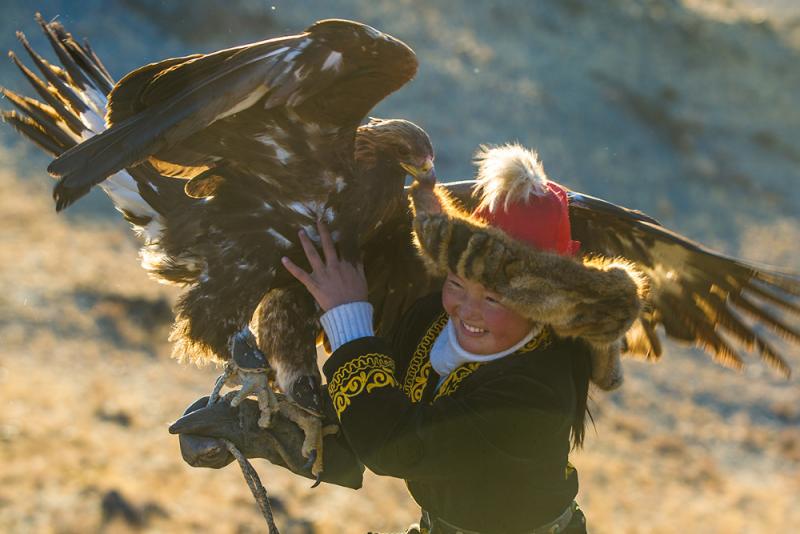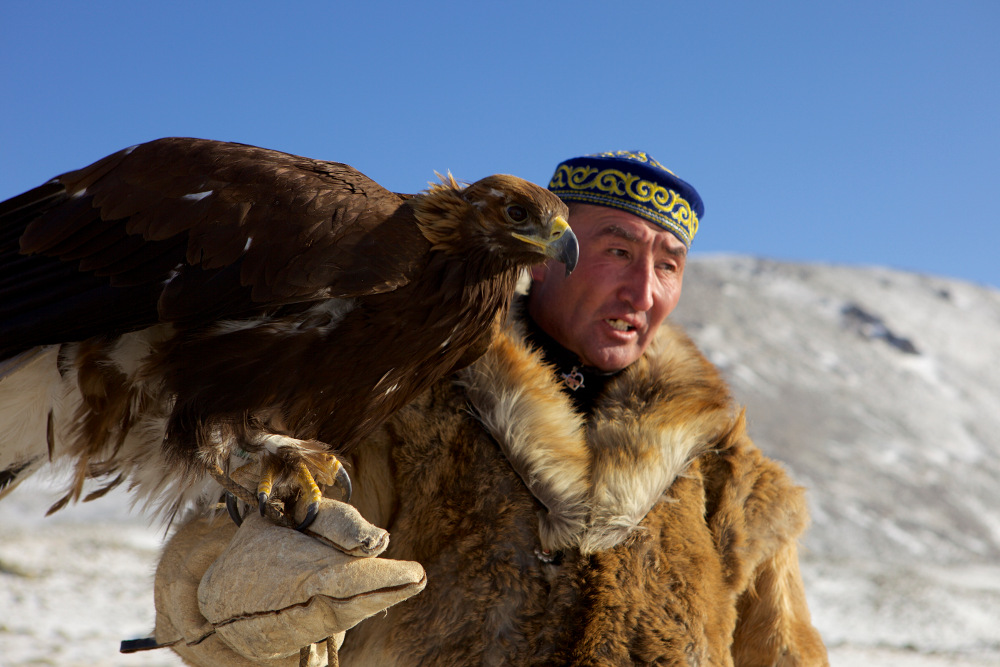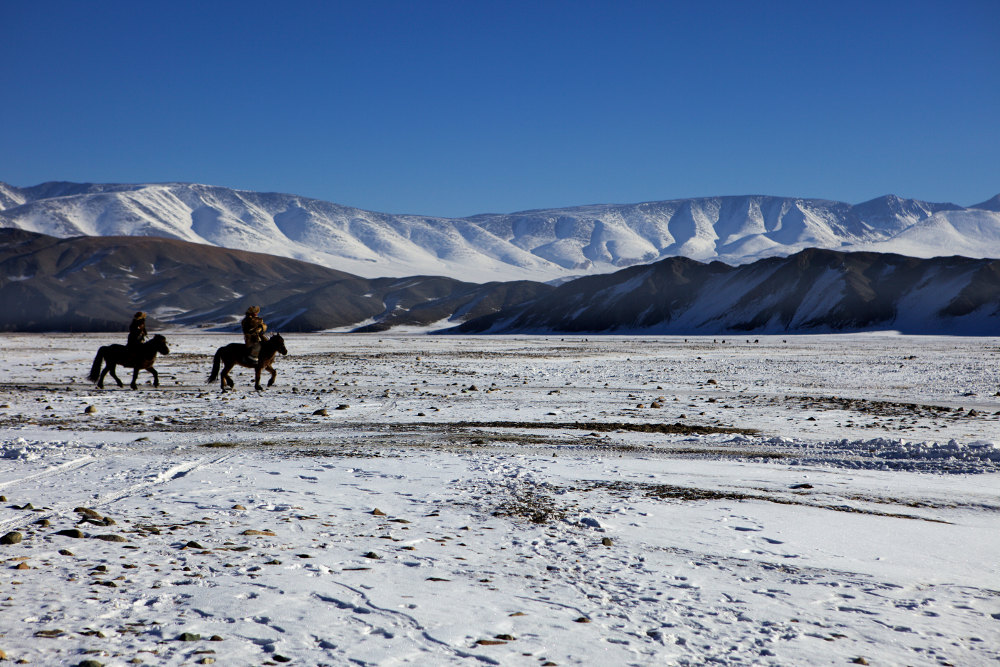The Eagle Huntress | reviews, news & interviews
The Eagle Huntress
The Eagle Huntress
Girl power Mongolian-style in a bewitching but problematic feature-doc

Thirteen-year-old Aishopan desperately wants to be an eagle hunter. The problem is, she’s a girl. And in the traditional Mongolian nomadic community where she lives, rearing a golden eagle chick to hunt foxes for their fur is very much the preserve of men.
British director Otto Bell’s sumptuous film is certainly an inspirational story of struggle and triumph, and it’s set against an arrestingly unfamiliar context – the icy peaks and frozen rivers at the crossroads between Mongolia, Kazakhstan, China and Russia. It’s a warm-hearted offering, almost to a fault – indeed, its set-pieces and lavish camerawork make it feel more feature than documentary – that charts the young Aishopan’s quiet determination to pursue her passion. And by her looks of unmitigated delight as she begins to train her eagle, a passion it clearly is. To demonstrate the villains of his story, Bell contrasts her enthusiasm with a remarkable sequence of fur-hatted elders shaking their heads at the audacity of this girl daring to step into their male-only world.
 It’s all beautifully delivered, family-friendly (except perhaps for the slaughtering of a sheep early on), and with a stirring message of equality and determination. And although The Eagle Huntress may not exactly challenge our preconceptions of exotic, yurt-inhabiting, horse-riding Mongolian nomads, it at least fills in some unexpected modern details – motorbikes, solar panels, and Aishopan’s rustic boarding school and the gaggle of excitable teenagers who share its dormitory.
It’s all beautifully delivered, family-friendly (except perhaps for the slaughtering of a sheep early on), and with a stirring message of equality and determination. And although The Eagle Huntress may not exactly challenge our preconceptions of exotic, yurt-inhabiting, horse-riding Mongolian nomads, it at least fills in some unexpected modern details – motorbikes, solar panels, and Aishopan’s rustic boarding school and the gaggle of excitable teenagers who share its dormitory.
Bell examines Aishopan’s warm, close relationship with her father Nurgaiv (pictured above) in tender detail. He’s an eagle hunter himself, with generations of tradition behind him, and entirely supportive of his daughter’s seemingly natural talent without being pushy. Their closeness emerges most touchingly – and dramatically – in the film’s pivotal eaglet-stealing scene, where Aishopan dangles precariously off a mountainside from a rope wrapped equally precariously around her father’s body, in order to snare what becomes her hunting bird.
Most memorable of all, though, is veteran nature photographer Simon Niblett’s astonishing cinematography of the Mongolian mountains and steppes (pictured below), often breathtaking in its endless vistas – and achieved with some stunning aerial shots from drones and cranes.
 But for all its ravishing camerawork and its inspirational message, there are some deep ironies here. The biggest one is the seeming lack of serious opposition to Aishopan taking part in the film’s climactic hunting competition – aside from a few frowns and raised eyebrows from the other competitors, hunters and judges alike actually seem amused and then impressed by her abilities. Other than the elders’ gentle disapproval, Bell simply doesn’t delve deeply enough into the nomadic society’s gender issues to explore any beliefs behind resistance to Aishopan’s ambitions. In fact, it’s Aishopan’s mother – who seems to have quite a distant, almost subservient relationship to both her husband and daughter – who most clearly embodies women’s rather restricted status.
But for all its ravishing camerawork and its inspirational message, there are some deep ironies here. The biggest one is the seeming lack of serious opposition to Aishopan taking part in the film’s climactic hunting competition – aside from a few frowns and raised eyebrows from the other competitors, hunters and judges alike actually seem amused and then impressed by her abilities. Other than the elders’ gentle disapproval, Bell simply doesn’t delve deeply enough into the nomadic society’s gender issues to explore any beliefs behind resistance to Aishopan’s ambitions. In fact, it’s Aishopan’s mother – who seems to have quite a distant, almost subservient relationship to both her husband and daughter – who most clearly embodies women’s rather restricted status.
It was probably a bit of a mistake, too, to use the rather mannered, disconcertingly on-off commentary from British actor Daisy Ridley (of Star Wars: The Force Awakens fame – also credited as an executive producer), who contributes so sporadically that each time she cuts in, you’d forgotten that there was a narrator at all.
There’s the unavoidable feeling by the end that reality has failed to delivery on Bell’s girl-against-the-world storyline. And his film’s rather paradoxical views on tradition – crucial to his picturesque portrayal of the nomads’ broader lives, but something to be challenged and subverted in Aishopan’s eagle-hunting ambitions – make it all the more problematic.
Thirteen-year-old Aishopan desperately wants to be an eagle hunter. The problem is, she’s a girl. And in the traditional Mongolian nomadic community where she lives, rearing a golden eagle chick to hunt foxes for their fur is very much the preserve of men.
British director Otto Bell’s sumptuous film is certainly an inspirational story of struggle and triumph, and it’s set against an arrestingly unfamiliar context – the icy peaks and frozen rivers at the crossroads between Mongolia, Kazakhstan, China and Russia. It’s a warm-hearted offering, almost to a fault – indeed, its set-pieces and lavish camerawork make it feel more feature than documentary – that charts the young Aishopan’s quiet determination to pursue her passion. And by her looks of unmitigated delight as she begins to train her eagle, a passion it clearly is. To demonstrate the villains of his story, Bell contrasts her enthusiasm with a remarkable sequence of fur-hatted elders shaking their heads at the audacity of this girl daring to step into their male-only world.
 It’s all beautifully delivered, family-friendly (except perhaps for the slaughtering of a sheep early on), and with a stirring message of equality and determination. And although The Eagle Huntress may not exactly challenge our preconceptions of exotic, yurt-inhabiting, horse-riding Mongolian nomads, it at least fills in some unexpected modern details – motorbikes, solar panels, and Aishopan’s rustic boarding school and the gaggle of excitable teenagers who share its dormitory.
It’s all beautifully delivered, family-friendly (except perhaps for the slaughtering of a sheep early on), and with a stirring message of equality and determination. And although The Eagle Huntress may not exactly challenge our preconceptions of exotic, yurt-inhabiting, horse-riding Mongolian nomads, it at least fills in some unexpected modern details – motorbikes, solar panels, and Aishopan’s rustic boarding school and the gaggle of excitable teenagers who share its dormitory.
Bell examines Aishopan’s warm, close relationship with her father Nurgaiv (pictured above) in tender detail. He’s an eagle hunter himself, with generations of tradition behind him, and entirely supportive of his daughter’s seemingly natural talent without being pushy. Their closeness emerges most touchingly – and dramatically – in the film’s pivotal eaglet-stealing scene, where Aishopan dangles precariously off a mountainside from a rope wrapped equally precariously around her father’s body, in order to snare what becomes her hunting bird.
Most memorable of all, though, is veteran nature photographer Simon Niblett’s astonishing cinematography of the Mongolian mountains and steppes (pictured below), often breathtaking in its endless vistas – and achieved with some stunning aerial shots from drones and cranes.
 But for all its ravishing camerawork and its inspirational message, there are some deep ironies here. The biggest one is the seeming lack of serious opposition to Aishopan taking part in the film’s climactic hunting competition – aside from a few frowns and raised eyebrows from the other competitors, hunters and judges alike actually seem amused and then impressed by her abilities. Other than the elders’ gentle disapproval, Bell simply doesn’t delve deeply enough into the nomadic society’s gender issues to explore any beliefs behind resistance to Aishopan’s ambitions. In fact, it’s Aishopan’s mother – who seems to have quite a distant, almost subservient relationship to both her husband and daughter – who most clearly embodies women’s rather restricted status.
But for all its ravishing camerawork and its inspirational message, there are some deep ironies here. The biggest one is the seeming lack of serious opposition to Aishopan taking part in the film’s climactic hunting competition – aside from a few frowns and raised eyebrows from the other competitors, hunters and judges alike actually seem amused and then impressed by her abilities. Other than the elders’ gentle disapproval, Bell simply doesn’t delve deeply enough into the nomadic society’s gender issues to explore any beliefs behind resistance to Aishopan’s ambitions. In fact, it’s Aishopan’s mother – who seems to have quite a distant, almost subservient relationship to both her husband and daughter – who most clearly embodies women’s rather restricted status.
It was probably a bit of a mistake, too, to use the rather mannered, disconcertingly on-off commentary from British actor Daisy Ridley (of Star Wars: The Force Awakens fame – also credited as an executive producer), who contributes so sporadically that each time she cuts in, you’d forgotten that there was a narrator at all.
There’s the unavoidable feeling by the end that reality has failed to delivery on Bell’s girl-against-the-world storyline. And his film’s rather paradoxical views on tradition – crucial to his picturesque portrayal of the nomads’ broader lives, but something to be challenged and subverted in Aishopan’s eagle-hunting ambitions – make it all the more problematic.
The future of Arts Journalism
You can stop theartsdesk.com closing!
We urgently need financing to survive. Our fundraising drive has thus far raised £49,000 but we need to reach £100,000 or we will be forced to close. Please contribute here: https://gofund.me/c3f6033d
And if you can forward this information to anyone who might assist, we’d be grateful.

Subscribe to theartsdesk.com
Thank you for continuing to read our work on theartsdesk.com. For unlimited access to every article in its entirety, including our archive of more than 15,000 pieces, we're asking for £5 per month or £40 per year. We feel it's a very good deal, and hope you do too.
To take a subscription now simply click here.
And if you're looking for that extra gift for a friend or family member, why not treat them to a theartsdesk.com gift subscription?
more Film
 Bugonia review - Yorgos Lanthimos on aliens, bees and conspiracy theories
Emma Stone and Jesse Plemons excel in a marvellously deranged black comedy
Bugonia review - Yorgos Lanthimos on aliens, bees and conspiracy theories
Emma Stone and Jesse Plemons excel in a marvellously deranged black comedy
 theartsdesk Q&A: director Kelly Reichardt on 'The Mastermind' and reliving the 1970s
The independent filmmaker discusses her intimate heist movie
theartsdesk Q&A: director Kelly Reichardt on 'The Mastermind' and reliving the 1970s
The independent filmmaker discusses her intimate heist movie
 Blu-ray: Wendy and Lucy
Down-and-out in rural Oregon: Kelly Reichardt's third feature packs a huge punch
Blu-ray: Wendy and Lucy
Down-and-out in rural Oregon: Kelly Reichardt's third feature packs a huge punch
 The Mastermind review - another slim but nourishing slice of Americana from Kelly Reichardt
Josh O'Connor is perfect casting as a cocky middle-class American adrift in the 1970s
The Mastermind review - another slim but nourishing slice of Americana from Kelly Reichardt
Josh O'Connor is perfect casting as a cocky middle-class American adrift in the 1970s
 Springsteen: Deliver Me From Nowhere review - the story of the Boss who isn't boss of his own head
A brooding trip on the Bruce Springsteen highway of hard knocks
Springsteen: Deliver Me From Nowhere review - the story of the Boss who isn't boss of his own head
A brooding trip on the Bruce Springsteen highway of hard knocks
 The Perfect Neighbor, Netflix review - Florida found-footage documentary is a harrowing watch
Sundance winner chronicles a death that should have been prevented
The Perfect Neighbor, Netflix review - Florida found-footage documentary is a harrowing watch
Sundance winner chronicles a death that should have been prevented
 Blu-ray: Le Quai des Brumes
Love twinkles in the gloom of Marcel Carné’s fogbound French poetic realist classic
Blu-ray: Le Quai des Brumes
Love twinkles in the gloom of Marcel Carné’s fogbound French poetic realist classic
 Frankenstein review - the Prometheus of the charnel house
Guillermo del Toro is fitfully inspired, but often lost in long-held ambitions
Frankenstein review - the Prometheus of the charnel house
Guillermo del Toro is fitfully inspired, but often lost in long-held ambitions
 London Film Festival 2025 - a Korean masterclass in black comedy and a Camus classic effectively realised
New films from Park Chan-wook, Gianfranco Rosi, François Ozon, Ildikó Enyedi and more
London Film Festival 2025 - a Korean masterclass in black comedy and a Camus classic effectively realised
New films from Park Chan-wook, Gianfranco Rosi, François Ozon, Ildikó Enyedi and more
 After the Hunt review - muddled #MeToo provocation
Julia Roberts excels despite misfiring drama
After the Hunt review - muddled #MeToo provocation
Julia Roberts excels despite misfiring drama
 Ballad of a Small Player review - Colin Farrell's all in as a gambler down on his luck
Conclave director Edward Berger swaps the Vatican for Asia's sin city
Ballad of a Small Player review - Colin Farrell's all in as a gambler down on his luck
Conclave director Edward Berger swaps the Vatican for Asia's sin city
 London Film Festival 2025 - Bradley Cooper channels John Bishop, the Boss goes to Nebraska, and a French pandemic
... not to mention Kristen Stewart's directing debut and a punchy prison drama
London Film Festival 2025 - Bradley Cooper channels John Bishop, the Boss goes to Nebraska, and a French pandemic
... not to mention Kristen Stewart's directing debut and a punchy prison drama

Add comment